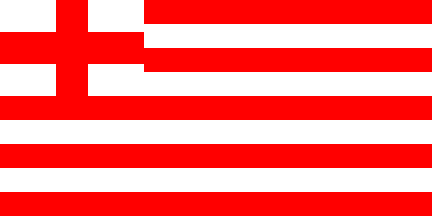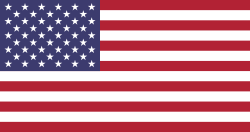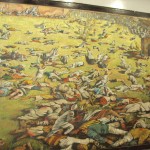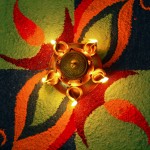This is an interesting bit on how USA’s Stars and Stripes flag was inspired by the flags of East India Company. The proof is below in the pictures of the flags of EIC and the various links.

(The flag that inspired the Stars and Stripes)

(Stars and Stripes)
The story of the flags of East India Company and the pictures of those different flags is given below.
(Downman (1685))
Lens (1700)
Rees (1820)
Laurie (1842)
The East India Company flag changed over time. From the period of 1600 to 1707 (Act of Union – England and Scotland) the flag consisted of a St George’s cross in the canton and a number of alternating Red and White stripes. After 1707 the canton contained the original Union Flag consisting of a combined St George’s cross and a St Andrew’s cross. After the Act of Union in 1800, that joined Ireland into the United Kingdom, the canton of the East India Company’s flag was altered accordingly to include the new Union Flag; with the additional St Patrick’s cross. There has been much debate and discussion regarding the number of stripes on the flag and the order of the stripes. Historical documents and paintings show many variations from 9 to 13 stripes, with some images showing the top stripe being red and others showing the top stripe being white.
At the time of the American revolution the East India Company flag would have been identical to the Grand Union Flag. The flag probably inspired the Stars and Stripes (as argued by Sir Charles Fawcett in 1937). [1] Comparisons between the Stars and Stripes and the Company’s flag from historical records present some convincing arguments. The John Company flag dates back to the 1600s whereas the United States adopted the Stars and Stripes in 1777[2].
Charles Fawcett’s Article arguing that the East India Company Flag inspired the Stars and Stripes:
The STRIPED FLAG of the EAST INDIA COMPANY, and its CONNEXION with the AMERICAN “STARS and STRIPES”
By Sir Charles FawcettAs Editor of the India Office series The English Factories in India I have become interested in the red and white stripes of the flag of the East India Company and the question whether they are the origin of the similar stripes in the American flag. I venture to give the result of my research on this topic in these pages, as it will, I think, be of some interest to readers of The Mariner’s Mirror, and no one else seems to have written about it in previous issues. Professor Geoffrey Callender, the Director of the National Maritime Museum, Greenwich, has informed me that the late Mr W. G. Perrin contemplated doing so, but had not completed his researches when he died. He has given a good deal of the history of the flag in his book British Flags (Cambridge University Press, 1922); but the only previous references to it in The Mariner’s Mirror are a few short notes on pp. 190 and 221 of vol. I and on p. 63 of vol. III, which chiefly relate to the varying number of the stripes.
In the seventeenth century the flag had, as stated by Perrin (loc. cit. p. 130), generally from nine to thirteen alternate red and white stripes, the odd numbers being red; and it was to this that its nick-name of “John Company’s gridiron” is due. The top stripes were, however, broken by a canton at the upper corner next the staff, containing the red cross of St George on a white field (see Perrin’s Plate IX, No. 6). Nothing about its use, or intended use, has been traced in the early records of the Company, though special attention to this point was paid by my predecessor, Sir William Foster, who has kindly helped me by putting his notes on the subject at my disposal. This may, however, be due to the incomplete state of the records or to usage rather than any formal order of the Company, having led to the adoption of these colours (1). That they were only red and white is shown by a document of 1668. In that year Bombay was transferred by King Charles II to the East India Company, and in September commissioners were sent down from Surat to take over the island. A new flag was required for the Fort and they asked that some white, red and blue cloth should be sent for making it, if the King’s colours (the Union Jack) were to be kept there; “if not, white and red will be sufficient”(2). That there were stripes on the flag is indicated by Peter Mundy’s drawing of it in a sketch of Swally Marine in 1656(3) and by Dr Fryer’s reference to it in 1673 as “the East-India striped Ancient”(4). There is also evidence that it had a cross on it, because in 1616 this was objected to by the Japanese as an emblem of Christianity, which had been banned in 1614. In 1671, when the Company was sending the Return to Japan in an effort to restart trade with that country, it decided not to alter its usual flag; but in 1673, when the ship entered the port of Nagasaki, she departed from this instruction on local advice and instead flew a striped white and red flag without a cross; when subsequently she put out one with a cross, the Japanese officials demanded an explanation(5). But all this is inconclusive as to its exact appearance. Fortunately a precise description of it at this period is afforded by extant coloured pictures of the four ships sent out to India by the Company in 1670. These were drawn by Edward Barlow, a seaman on one of them (the Experiment), who wrote an account of his various voyages and illustrated it with coloured sketches. This is now in the possession of Mr Basil Lubbock, who has edited it in his book Barlow’s Journal (Hurst and Blackett, 1934). Three of his pictures showing the ships, or some of them, at Bombay, at Calicut and near Surat, are reproduced in the latest volume of The English Factories in India, recently published by the Clarendon Press, Oxford. These depict the flag with alternate red and white stripes and the canton with St George’s cross, exactly as it has been described above. Similar illustrations that show the flag clearly have been reproduced (though not in colour) in Barlow’s Journal opposite pp. 184, 190, 194, 198 and 200, while another one facing p. 358 shows it on a ship in which he sailed to the East in 1683. The number of stripes on his Bags is generally 9, 11, or 13, but there are instances of 7 and even 19 (the latter being on the ship of 1683, the other flag on which has 13 stripes), so obviously too much stress should not be laid on such variations. All that can safely be said about it is that Barlow’s pictures support the view that the number varied and was generally from 9 to 13. They also show that a ship would sometimes wear, in addition to the Company’s usual flag, the red ensign with a canton having a red St George’s cross on a white field (6), which was then commonly worn by merchantmen and their use of which was expressly authorized by a proclamation issued by Charles II on 18 September 1674 (Perrin, loc. cit. pp. 68-9, 130).
In November 1676 Samuel Pepys drew the attention of the Company to the fact that its flag continued to be flown by its ships in contravention of this proclamation, which prescribed for “merchants’ ships” the use of only two flags, viz. the red ensign just mentioned and “the Flag and Jack white with a red cross (commonly called Saint George’s Cross) passing right through the same”(7). On 6 December of that year the Court of Committees, as the Company’s directors were then called, asked the Shipping Committee to confer -with the commanders of the three ships that were then about to sail for the Coromandel Coast and the Bay of Bengal ‘touching the colours enjoined by Royal proclamation to be worn by all merchant ships mentioned, and how far it may be useful or inconvenient to the Company’s affairs to have any alteration made in the ensign hitherto worn by their ships, and report”. Evidently as a result of this the Court of Committees on 19 December instructed each of the commanders to note that between St Helena and England in his homeward voyage, as also when going out, he was in obedience to the King’s proclamation “to wear only the usual English flag and ensign, and no other, viz, a white flag with a red cross, and a red ensign with a white cross in the upper corner”(8). The description of the red ensign’s canton as “a white cross” was an obvious error which was corrected by substituting the words ‘a red cross in a white field” in subsequent similar instructions to commanders.(9) These continued up to September 1688, after which the order in question does not appear in them.(10)
This does not, however, mean that the order had been annulled or that it ceased to be observed. Its restriction to home waters and those between St Helena and this country was a compromise, which was undoubtedly acquiesced in by the Admiralty; but that body would on the other hand be interested in the enforcement of this arrangement and there is nothing to indicate that it consented, in or about 1688-9, to any further relaxation of the terms of the proclamation of 1674, except to the extent that I suggest below. The reason for the omission of the usual clause after September 1688 is not on the records of the Company, but I venture to put forward a possible explanation of it. When the next ships were about to be dispatched in March-May 1689, William III was on the throne and England was on the brink of war with France over Louis XIV’s support of the ex-King, James II. Under a royal warrant of 9 May 1689 the Company was authorized to commission their commanders to seize French vessels as prizes(11); in other words its ships were virtual privateers. In the seventeenth century the latter were in the habit of wearing the Union Jack,(12) so that the order in question might well be regarded as inappropriate.















